

ALRANZ I Home. Evolving Minds Want To Know...: A Pro-Choice Response. [UPDATE: On September 27, 2012, the day after motion 312 failed 91-203, Conservative Parliament member Mark Warawa announced he would introduce a motion to condemn discrimination against females via sex-selective pregnancy termination.
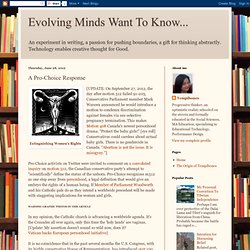
This makes Motion 408 Canada's newest personhood drama. "Protect the baby girls! " [eye roll] Conservatives could careless about actual baby girls. There is no gendercide in Canada. Abortion in New Zealand. Abortion in New Zealand is legal in cases where the pregnant woman faces a danger to her life, physical or mental health, or if there is a risk of the fetus being handicapped, in the event of the continuation of her pregnancy.

In cases not protected by these grounds, aborting an unborn child is a crime in New Zealand under the Crimes Act 1961. Regulations in New Zealand require that abortions after 12 weeks gestation be performed in a "licensed institution", which is generally understood to be a hospital. Abortions must be approved by two doctors (referred to as "certifying consultants" within the legislation) — one of whom must be a gynaecologist or obstetrician.
Counselling is optional if the woman desires it, but is not mandatory under current abortion law. There is no statutory definition of fetuses or embryos as an "unborn child" within New Zealand abortion law. History[edit] The 1936 Committee of Enquiry headed by D.G. Werewolf » Fighting To Choose. An excerpt from Alison McCulloch’s new book about the battle for abortion rights in New Zealand by Alison McCulloch Alison McCulloch’s new book “Fighting to Choose: The Abortion Rights Struggle in New Zealand” (Victoria University Press) is being released in May.

This abridged excerpt from Chapter 4 of the book looks at the opening in 1974 of the Auckland Medical Aid Trust’s abortion clinic, a move that sparked a political firestorm culminating in the passage in 1977 of the Contraception, Sterilisation and Abortion Act and its amendments to the Crimes Act – the laws that govern abortion access today. On 17 May 1974, in a refitted residential house in the Auckland suburb of Remuera, the non-profit Auckland Medical Aid Trust opened New Zealand’s first abortion clinic. For $80, it provided women who met the legal criteria with counselling and pregnancy termination. Photo credit: The Dominion Post / Fairfax. Fighting to Choose: the Abortion Rights Struggle in New Zealand – International Socialists. Abortion is a health matter, not a crime. The Cider House Rules. Plot[edit] Wilbur's and Homer's lives are complicated by Wilbur also secretly being an abortionist.

Wilbur came to this work reluctantly, but he is driven by having seen the horrors of back-alley operations. Homer, upon learning Wilbur's secret, considers it morally wrong. As a young man, Homer befriends a young couple, Candy Kendall and Wally Worthington, who come to St. Cloud's for an abortion. Subsequently, Wally is found in Burma and returns home, paralyzed from the waist down. Many years later, teenaged Angel falls in love with Rose. A subplot follows the character Melony, who grew up alongside Homer in the orphanage.
Background[edit] The story about Wally being shot down over Burma was based in part on that of Irving's biological father (whom he never met), who had been shot down over Burma and survived.[1] References[edit] Jump up ^ Mel Gussow (1998-04-28). Abortion debate. The abortion debate refers to the ongoing controversy surrounding the moral and legal status of abortion.
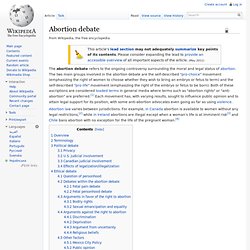
The two main groups involved in the abortion debate are the self-described "pro-choice" movement (emphasizing the right of women to choose whether they wish to bring an embryo or fetus to term) and the self-described "pro-life" movement (emphasizing the right of the embryo or fetus to be born). Both of these ascriptions are considered loaded terms in general media where terms such as "abortion rights" or "anti-abortion" are preferred.[1] Each movement has, with varying results, sought to influence public opinion and to attain legal support for its position, with some anti-abortion advocates even going as far as using violence. Abortion law varies between jurisdictions. Overview. Anti-abortion violence. Anti-abortion violence is violence committed against individuals and organizations that provide abortion.[1] Incidents of violence have included destruction of property, in the form of vandalism; crimes against people, including kidnapping, stalking, assault, attempted murder, and murder; and crimes affecting both people and property, including arson and bombings.
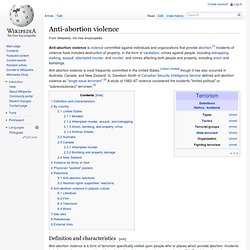
Anti-abortion violence is most frequently committed in the United States,[citation needed] though it has also occurred in Australia, Canada, and New Zealand. G. Davidson Smith of Canadian Security Intelligence Service defined anti-abortion violence as "single issue terrorism".[2] A study of 1982–87 violence considered the incidents "limited political" or "subrevolutionary" terrorism.[3] Definition and characteristics[edit]
After Tiller. After Tiller is a 2013 documentary film directed by Martha Shane and Lana Wilson that follows the only four remaining doctors in the United States who openly perform late-term abortions.
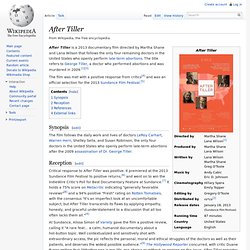
The title refers to George Tiller, a doctor who performed abortions and was murdered in 2009.[1][3] The film was met with a positive response from critics[4] and was an official selection for the 2013 Sundance Film Festival.[5] Abortion. Abortion, when induced in the developed world in accordance with local law, is among the safest procedures in medicine.[1] However, unsafe abortions result in approximately 47,000 maternal deaths[2] and 5 million hospital admissions per year globally.[3] An estimated 44 million abortions are performed globally each year, with slightly under half of those performed unsafely.[4] The incidence of abortion has stabilized in recent years,[4] having previously spent decades declining as access to family planning education and contraceptive services increased.[5] Forty percent of the world's women have access to legal induced abortions (within gestational limits).[6] Induced abortion has a long history and has been performed by various methods, including herbal abortifacients, the use of sharpened tools, physical trauma, and other traditional methods.

Contemporary medicine utilizes medications and surgical procedures. History of abortion. The practice of abortion, the termination of a pregnancy so that it does not result in birth, dates back to ancient times.

Pregnancies were terminated through a number of methods, including the administration of abortifacient herbs, the use of sharpened implements, the application of abdominal pressure, and other techniques. Abortion laws and their enforcement have fluctuated through various eras. In many western nations during the 20th century various women's rights groups, doctors, and social reformers successfully worked to have abortion bans repealed.
Late termination of pregnancy. Late termination of pregnancy (TOP)[1] or late-term abortions are abortions which are performed during a later stage of pregnancy.
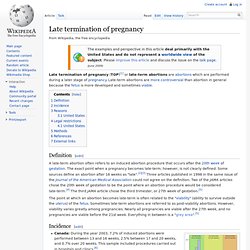
Late-term abortions are more controversial than abortion in general because the fetus is more developed and sometimes viable. Definition[edit] A late-term abortion often refers to an induced abortion procedure that occurs after the 20th week of gestation. The exact point when a pregnancy becomes late-term, however, is not clearly defined. Abortion law. Adultery. Adultery (anglicised from Latin adulterium) is a type of extramarital sex. Interpretations of what constitutes adultery vary widely, as do the religious and legal consequences of the acts in question. The term adultery has an Abrahamic origin, though the concept predates Judaism and is found in many other societies.
The definition and consequences vary between religions culture benefits and legal jurisdictions, but the concept is similar in Islam, Christianity and Judaism.[1] Historically, adultery has been considered to be a very serious offense by many cultures, with the act of a man having sexual relations with another man's wife most often incurring very severe punishment for both the wife and her lover, such as the death penalty, mutilation or torture.[2] Such punishments have gradually fallen into disfavor, especially from the 19th century onwards.